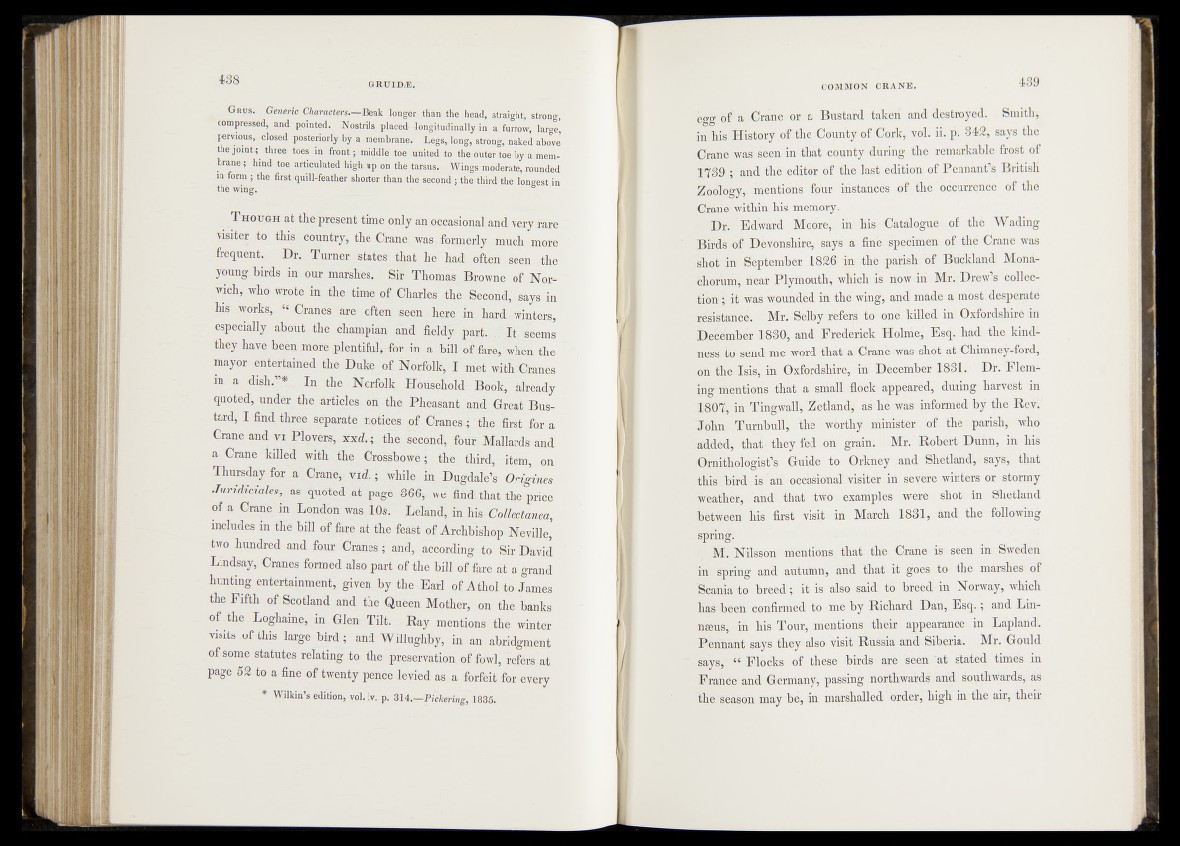
Grus. Generic Characters.—Beak longer than the head] straighfr./sWg,
compressed, and pointed. Nostrils.,placedr-lengitud inally in a/fiirrow,laigc,
pervious, closed posteriorly hy a membrane.-' Legs,'l o ^ Ë ^ ^ H H a b o v e '
the joint; three toes in front; midd]e~'toe4united to thfe^utër to#?hffa?mem-
brane; hind toe articulated high-.up. ;oji .the tarsus. . Kings moderate, rounded
m form; the .first quill-feather shorter than th ^ s ^ n d f th e third the-l|ngèstin
the wing. _ • °
T hough at the present timubnly an^casional and very rare
visiter tb' this county, the Crane was.formerly 'mich moril
Sequent. Dr. Turner states that he had often seen, d ie
young birds in our marshes. Si! Thomas_ Browne,^ NorM
wich, who wrote in the time of Charles the :i.|ee^id^says in
his works, “ Cranes are often seen-here in . hard^winters,
” especially about the champian and“ fieldy- part. . I t lëems"
they have been more plentiful,-for in a bill o f ||e ,k h e n the
mayor entertained the Duke of Norfolk, I “met wltËCranes
in a m ^ * r In the. Norfolk HoüsehoLd^.Bog kjfèady
quoted, under the articles on the Pheasant^atd Great Bustard,
I find three separate notices of Cranes^tEe firftjo r a
Crane and vi Plover^ xxd,; the Jecond; four Mallards and
a Crane killed with the Crossbowe; the ' thirdg.M B P j
Thursday for a Crane, vid. ; while in DugdaleV Origines
Juridiciales, as quoted at page 366^we find^kfethe price
of a Crane in London was 10s. Leland^ in . fci|,
includes in th% bill of, % e a t the feast o f Archbishop i|è y i% '
two hundred and four Cranes; and, according^ Sir David
Lindsay, Cranes formed also part of the bill of fare at a grand
hunting;entertainment; given by the Earl of iUhol-to James
the Fifth-of Scotland and the Queen Mother, on. the banks
of the Loghaine, in Glen Tilt. Ray mentions, the winter
visits .of this large bird; and WillughEy, in an abridgment
of some statutes relating .to the preservation offowl, refers at
page 5% to a fine of twenty pence levied as a forfeit for every
* Wilkin’s edition, yobiv. p. ^U .—Pickering, \ 835.
etrff of a Crane or a Bustard taken and destroyed, Smithy
°f ^ p- say# the
C ran e^w ^ p k ijn th ^ k n ^ 'ty ' during t^ rem a rfe a l^ : frost of
ifySB',; and-the* editor f t t h e last edition of Pennant’s British
£ o i$ S |, m en tio n four instances /of , the occurrence of the
Cran^H^in- his memdry. ^
‘Edward hi^Cat&loghe^of the Wading
Birds o f D'|v6'nshire,- ^her Crane was
dh#-Jn p^ftember in- the parish of • Buckland Mondfchorum,
near Pd}mouth'? vMclf is Mr.'Drew’s collection^
«it was w ood ed in th^win^, ’ andinfade ,a most desperate
resistancfk Mr. *^ li% ^ler^|ooone "killed in Oxfordshiifedn
D ^ m b lA ft% ; and- S h r in k HolMe,’JEsq. had the kind-
^ ^fefel^Tne word that^nvCfane^wast* shot at Chimney-ford3
on the^llis, in q ^ fd rd k ifep in DM^femr 1331. Dr. Flem-
iP ^ lH i ^ ' h a t a ’smal&Ak^^peargd, during harvest in
Ting^M^Zetl'andf/ as he. was informedky the R e t;
"John p fetrn b h lf thfe ' tv!irthy^iwinisfer.-fof the- parish, who
Added; thafethe^|f||'@ri.i‘ grain. Mr. Rpkert Dunn, in his
Ornithologist's Guide to Orl^^^/^p'dT Shetland?,'; says;-, that
■,thls*~'Mfd is"a^qc'cagionaitvtisite'f*in seyike’winters or stormy
^ a th e i, anch that two* examples -were shot in Shetland
between his first’ ivisit iri March 1831, and the following
$]Uang:
M. NiilsSOrfr-' foehtions that1' the. Crane-is seen.' in- Sweden
in ^Spring and autumn, arid that S f :?go'e^ to the marshes of
IScania to breed-; it is1 also' said” to breed in Norway, which
haj^toe'fen confirmed to me by Richard Dan, Esq.; iand Lin-
'nseus, in his Tour,.mention^, their, appearance in Lapland.
PeriUant says ' they-also visit'- Russia andSiberia. Mr. 'Gould
days,' §3 Flocks of these birds hre. seen 'at stated times in
France and Germany, passing.. northwards and southwards, as
the" season may be, in marshalled order, high in‘the air, their